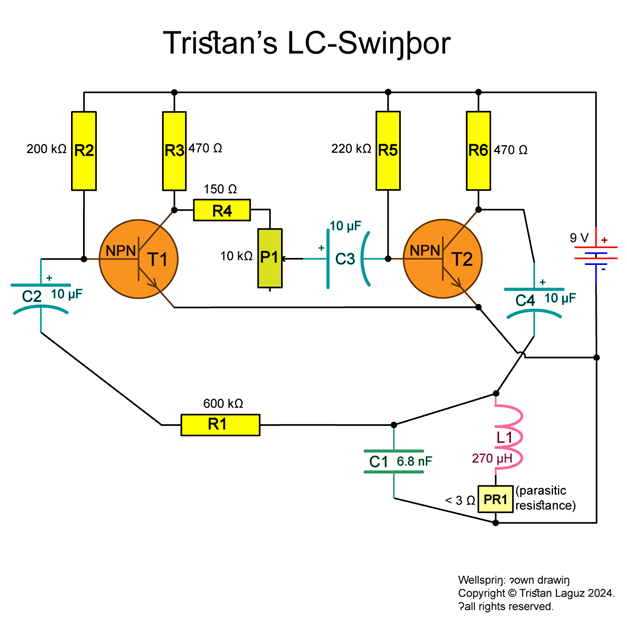The first self-sustaining swinging circuit I learned of is Colpitt’s oscillator. This circuit uses a capacitive voltage splitter. I thought it should be possible to make a self-sustaining swinging circuit which contains a simple LC circuit made up of a single inductor and a single capacitor, an oscillator which doesn’t make use of any capacitive or inductive voltage division. So I tried and succeeded to come up with such a swinger. I looked in thought to an actual swing for inspiration and thereby found that the oscillator could be realized by at each time point boosting the voltage of the tank circuit in the direction which it has at that time point. I realized that an AC amplifier would do the trick. So I fed the voltage of the tuned circuit into the input of the AC booster and fed the latter’s output back into the resonant circuit. Here’s the diagram of the circuit I drew up and built:

With the values for capacitance, inductance, and parasitic resistance given in the diagram, the circuit swang at approximately 104 kHz. Then, I played around with the LC circuit a bit. By removing the 6.8 nF capacitor, I achieved ca. 333 kHz. It seems the springs of my circuit board have enough parasitic capacitance. I switched the inductor out for a solenoid spool and thereby achieved about 833 kHz. Finally, by putting an iron core into the spool, I reached around 1.25 MHz. The differential equation for an LC circuit is: $$\frac{1}{C}Q(t) = -\dot{Q}(t)R - \ddot{Q}(t)L \text{,}$$ which is equivalent to $$\ddot{Q}(t) + \frac{R}{L}\dot{Q}(t) + \frac{1}{LC}Q(t) = 0 \text{.}$$ This shows that the resonant circuit swings for $$R < 2 \sqrt{\frac{L}{C}}$$ at a frequency of $$f = \frac{1}{2\pi} \sqrt{\frac{1}{LC} - \frac{R^2}{4 L^2}} \text{.}$$ For the values shown on the diagram, this gives us about 117 kHz, which fits well with the aforesaid measured value of 104 kHz. The forecast is a bit too high probably because the capacitance is really a bit higher than 6.8 nF due to the abovementioned parasitic capacitance. The matching between forecast and measured valued shows that it's really the LC circuit that swings.
I need the potentiometer to adjust the resistance between the first transistor and the second precisely. When the resistance is too high, the swinging dies down. When it’s too low, the oscillations are distorted due to clipping. By hitting the sweet spot in the middle, I get nice sinusoidal waves.
A good feature my circuit shares with Colpitt's is that it's self-startig; it begins to swing on its own.
It may help if you construct my circuit yourself and test it.
I looked for different swinging circuits on Wikipedia but found none which don’t use inductive or capacitive voltage splitting. Considering that my circuit is the simplest I can think of (it’s just an LC circuit and an AC amplifier forming a positive feedback loop), I’m pretty sure it already has a name. So, what is this circuit called?
And why does it seem to be seldom used? A possible explanation I can think of is that the need for fine tuning with the variable resistor indicates my swinging circuit isn’t very stable. Is this correct?
